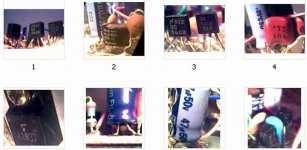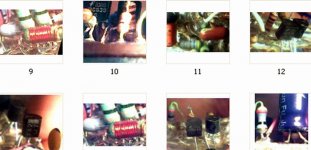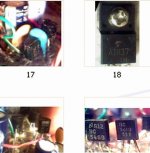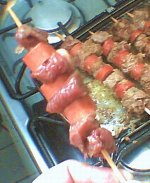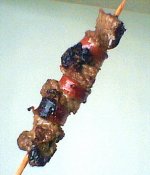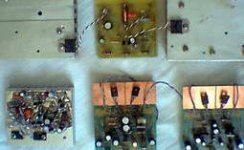Mike,
Got a question for your spice program. I think I've got a decent layout for everything up to the bd135. Then, I've got two different mechanical approachs to building the box. It'll make a nicer package if I can connect to the bd135 with about 8cm of straight wire. I looked on a calculator and come up with about 80nH for that. Would that create any resonance issues? I have an alternate way to package everything with 1-2 cm connecting wire, but it's not as neat. Either way, all the transistors on the heat sink will be close together.
Thanks,
Sheldon
Got a question for your spice program. I think I've got a decent layout for everything up to the bd135. Then, I've got two different mechanical approachs to building the box. It'll make a nicer package if I can connect to the bd135 with about 8cm of straight wire. I looked on a calculator and come up with about 80nH for that. Would that create any resonance issues? I have an alternate way to package everything with 1-2 cm connecting wire, but it's not as neat. Either way, all the transistors on the heat sink will be close together.
Thanks,
Sheldon
MikeB said:Hi Sheldon,
The cap in paralell (22pf) to the feedbackresistor is a "phaseshifter",
partially reverting the phaseshift introduced by the circuit from
input to output. It's mainpurpose is avoiding overshooting.
The other cap in series with the 499ohm, is a DC-blocking cap.
It has 2 functions, the first is to reduce gain down to 1:1 for DC,
enabling the whole openloopgain to feedback for DC.
The second is, by increasing the 499ohms to infinite for DC, the
inputresistance of the -input of diffamp becomes 22k at DC, the
same as on +input. This results in identical inputoffsets on both
sides of the inputpair, again greatly reducing DC-offset at ouput.
Or did you mean the 330pf in vas to gnd ?
Sajti, good to hear from your progress, the MJL21193/4 are nice transistors !
One thing i did not understand, most asymetrical inputs use pnp-devices, why ?
Aren't npn's more linear ?
Mike
Hi Mike,
I think, that PNPs have higher B, than NPNs. And at the beginning there was not too much high voltage PNP transistors to use as VAS. So everybody used PNP input, and NPN for VAS...
sajti
There are people re-visiting this or that, and i am re-inventing the Weel and the ...
Powder without smoke too.... ahahaha!
The discrete chip was interesting...i was watching, and i think i could make it better...because all components inside... a little bit larger than some STK ...but, output Transistors goes out of the chip....hehe...new model.
Life sometimes can be heavy...i use to have fun, this is some enormous compensation i found..to watch the funny things that life is showing me.
Also i discovered that is wonderfull to laugh from ourselves...better than laugh from others...as the other will turn "pisted" and i never feel this way with myself.
I have a good agreement with myself, not to fight against myself.
regards my dear Workhorse.... explendid amplifier you do..i could see it...and your well cutted nails too!
regards,
Carlos
Powder without smoke too.... ahahaha!
The discrete chip was interesting...i was watching, and i think i could make it better...because all components inside... a little bit larger than some STK ...but, output Transistors goes out of the chip....hehe...new model.
Life sometimes can be heavy...i use to have fun, this is some enormous compensation i found..to watch the funny things that life is showing me.
Also i discovered that is wonderfull to laugh from ourselves...better than laugh from others...as the other will turn "pisted" and i never feel this way with myself.
I have a good agreement with myself, not to fight against myself.
regards my dear Workhorse.... explendid amplifier you do..i could see it...and your well cutted nails too!
regards,
Carlos
Thanh, you did not asked me...but... as Mike may delay, i will advance some ideas
There are a lot of people that only measure the voltage that appear in Digital multimeters and conclude that transistor are matched or not.... they may be matched when showing the same value in the display I DO NOT KNOW.... and i have strong suspections that will not work, because, those instruments have separated HFE measurement plugs...if possible to obtain the matched or unmatched data with that reading...no need to supply HFE position and HFE plugs to measure transistor gain....as this may be expensive to industrie, and they do not apreciate to waste money...i can conclude that the method will have reasonable possibilities that wont work properly.
But, as you already know, normally people use some simple circuit, battery driven to measure.
This measurement are not precise too, because do not use the correct voltage....measuring the gain of a power transistor with only 1 miliampere entering the base do not make too much sense to me...and those meters do that.
They force one current in the Base to Emitter circuit and another current, a much bigger current will flow from Colector to Emitter, so, they divide this output current with the input current to obtain the current ratio.... the DC current gain.
This is the method more used, and more common to find, and you can construct if you Multimeter do not have this, normally included, facility that is called HFE........ the real measurement made is the DC ratio..... i think no AC is entering, and i do not know exactly if the DC method is 100% precise.
I have to inform you that i made the last Symassym without match nothing...and worked very well...off set jumped to 24 milivolts.... this was the easy and visible result....more details we have to ask the distortion analisers...as they will not tell us...better not to ask them....our ears will show a good result too.
regards,
Carlos
There are a lot of people that only measure the voltage that appear in Digital multimeters and conclude that transistor are matched or not.... they may be matched when showing the same value in the display I DO NOT KNOW.... and i have strong suspections that will not work, because, those instruments have separated HFE measurement plugs...if possible to obtain the matched or unmatched data with that reading...no need to supply HFE position and HFE plugs to measure transistor gain....as this may be expensive to industrie, and they do not apreciate to waste money...i can conclude that the method will have reasonable possibilities that wont work properly.
But, as you already know, normally people use some simple circuit, battery driven to measure.
This measurement are not precise too, because do not use the correct voltage....measuring the gain of a power transistor with only 1 miliampere entering the base do not make too much sense to me...and those meters do that.
They force one current in the Base to Emitter circuit and another current, a much bigger current will flow from Colector to Emitter, so, they divide this output current with the input current to obtain the current ratio.... the DC current gain.
This is the method more used, and more common to find, and you can construct if you Multimeter do not have this, normally included, facility that is called HFE........ the real measurement made is the DC ratio..... i think no AC is entering, and i do not know exactly if the DC method is 100% precise.
I have to inform you that i made the last Symassym without match nothing...and worked very well...off set jumped to 24 milivolts.... this was the easy and visible result....more details we have to ask the distortion analisers...as they will not tell us...better not to ask them....our ears will show a good result too.
regards,
Carlos
Sheldon said:Mike,
Got a question for your spice program. I think I've got a decent layout for everything up to the bd135. Then, I've got two different mechanical approachs to building the box. It'll make a nicer package if I can connect to the bd135 with about 8cm of straight wire. I looked on a calculator and come up with about 80nH for that. Would that create any resonance issues? I have an alternate way to package everything with 1-2 cm connecting wire, but it's not as neat. Either way, all the transistors on the heat sink will be close together.
Thanks,
Sheldon
Hi Sheldon, as long as you have the 100nf on the opposite side of
the wire to the bd135 it should not be a problem, on my layout
i also have ~4cm of thin wires. Do you have a scope to ensure
that you have no local oscillation ?
thanh said:Mikeb! I have just bought a digital multimeter which has the "diode function " . Can I use it to match transistor ?
I think not, the best way to do matching is building a small circuit.
I use a ccs to emitter, a 10k+10k divider with 100k to base.
So i can measure across the 100k the basecurrent.
sajti said:
Hi Mike,
I think, that PNPs have higher B, than NPNs. And at the beginning there was not too much high voltage PNP transistors to use as VAS. So everybody used PNP input, and NPN for VAS...
sajti
Ah, a relict from old days ?
Mike
I could not find gain 900 transistors as Mike is using.
In the reality, i have to confess (I am old) that i never had measured a "non darlington" transistor with more than 550 of gain.
Those modern units Mike is using are wonderfull, and unreachable here.... and may result very different.
Well, my amplifier is sounding very good, and i feel shocked with that enormous difference in gain, and even this way sounding good.
Yes!...i have asked friends to hear and all them evaluate it as a very good amplifier too.....not only my evaluation, as i do not use my evaluations because only one guys opinnion is not something precise enougth, there are human factors that can change a little the evaluations.
For instance, personally i hate snobish guys, and i imagine that my evaluation of some "Snobberamp" will be not fair, because i am not a machine.... this guys amplifier cannot be presented to me before my audition, because it is hardly possible that i will not apreciate it.
And this is not very strange..... think about the idea i will explain you.
You may love Violin.... you may feel good with the sound....many years hearing and apreciating the Violin sound..... chords...you happy with violin.....but...someday one man that plays Violin very well started to watch your wife with interest.... and the damned advanced too much, and despite respectable woman, you wife felt enormous empathy with the Violinist, because his art, his capacity of play wonderfull songs....and you turning green with that damn thing, and the stupid Violinist wanting your wife, and you wanting to break the Violin into his head.
I will not like his Violin music anymore...Am i unfair in my judgement...no!...i am human!
Reason why the Enginners, some Numerologists, Number-0-Logists, apreciate so much numbers, as they are afraid of the ones play Violin better than they can....ahahahha.
Kidding.
Well...by the way Mike.... i will have your prefered food... Schligtisch or something alike.... will be burned till be toasted...hehe...cheers.
regards,
Carlos
In the reality, i have to confess (I am old) that i never had measured a "non darlington" transistor with more than 550 of gain.
Those modern units Mike is using are wonderfull, and unreachable here.... and may result very different.
Well, my amplifier is sounding very good, and i feel shocked with that enormous difference in gain, and even this way sounding good.
Yes!...i have asked friends to hear and all them evaluate it as a very good amplifier too.....not only my evaluation, as i do not use my evaluations because only one guys opinnion is not something precise enougth, there are human factors that can change a little the evaluations.
For instance, personally i hate snobish guys, and i imagine that my evaluation of some "Snobberamp" will be not fair, because i am not a machine.... this guys amplifier cannot be presented to me before my audition, because it is hardly possible that i will not apreciate it.
And this is not very strange..... think about the idea i will explain you.
You may love Violin.... you may feel good with the sound....many years hearing and apreciating the Violin sound..... chords...you happy with violin.....but...someday one man that plays Violin very well started to watch your wife with interest.... and the damned advanced too much, and despite respectable woman, you wife felt enormous empathy with the Violinist, because his art, his capacity of play wonderfull songs....and you turning green with that damn thing, and the stupid Violinist wanting your wife, and you wanting to break the Violin into his head.
I will not like his Violin music anymore...Am i unfair in my judgement...no!...i am human!
Reason why the Enginners, some Numerologists, Number-0-Logists, apreciate so much numbers, as they are afraid of the ones play Violin better than they can....ahahahha.
Kidding.
Well...by the way Mike.... i will have your prefered food... Schligtisch or something alike.... will be burned till be toasted...hehe...cheers.
regards,
Carlos
Attachments
Well Miky, i can wait a little, but please, take this airplane fast to lunch with me
I have a good wine, and you are invited my dear.
Ahahaha (today i am beeing a little bit sadic with him)
He deleted one MP3 audio message i sent him, because lazy to buy PC speaker...i am in bad mood related Mike.... but will be OK!.... after i punish him showing the "Schaschlik"
regards,
Carlos
I have a good wine, and you are invited my dear.
Ahahaha (today i am beeing a little bit sadic with him)
He deleted one MP3 audio message i sent him, because lazy to buy PC speaker...i am in bad mood related Mike.... but will be OK!.... after i punish him showing the "Schaschlik"
regards,
Carlos
Attachments
MikeB said:
Hi Sheldon, as long as you have the 100nf on the opposite side of
the wire to the bd135 it should not be a problem, on my layout
i also have ~4cm of thin wires. Do you have a scope to ensure
that you have no local oscillation ?
Yes, the 100nf is on the board with the input and the n5401 differential, as you had suggested earlier. If I keep fiddling around making circuits, I may have to get a scope one of these days.
Thanks,
Sheldon
Re: Well Miky, i can wait a little, but please, take this airplane fast to lunch with me
maybe better "shaschweek"?
destroyer X said:"Schaschlik"
maybe better "shaschweek"?
For a while, waiting those guys are producing, and crazy to hear their evaluation
And my own production running fast.
This weekend production will be tested, they are old amplifiers, the first Aksas i had (Have more 5 units) modified to reproduce only hi frequencies, and other to voices.... one experience unit and one Symassym to fire up.
After completion, the real fun will start...to compare them.
regards,
Carlos
And my own production running fast.
This weekend production will be tested, they are old amplifiers, the first Aksas i had (Have more 5 units) modified to reproduce only hi frequencies, and other to voices.... one experience unit and one Symassym to fire up.
After completion, the real fun will start...to compare them.
regards,
Carlos
Attachments
Some FFT-plots
Hi !
I just realized that i have not posted some distortion-plots yet...
Here they are:
2.8v peak into 4ohms, 1khz:
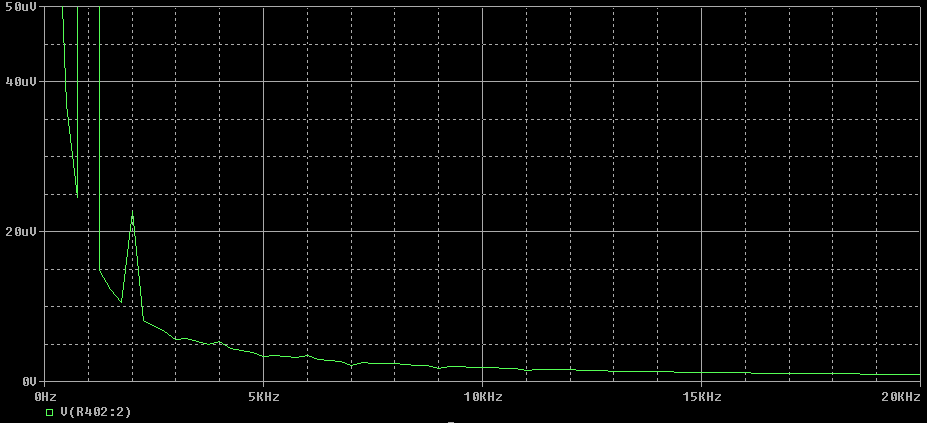
2.8v peak into 4ohms, 10khz:
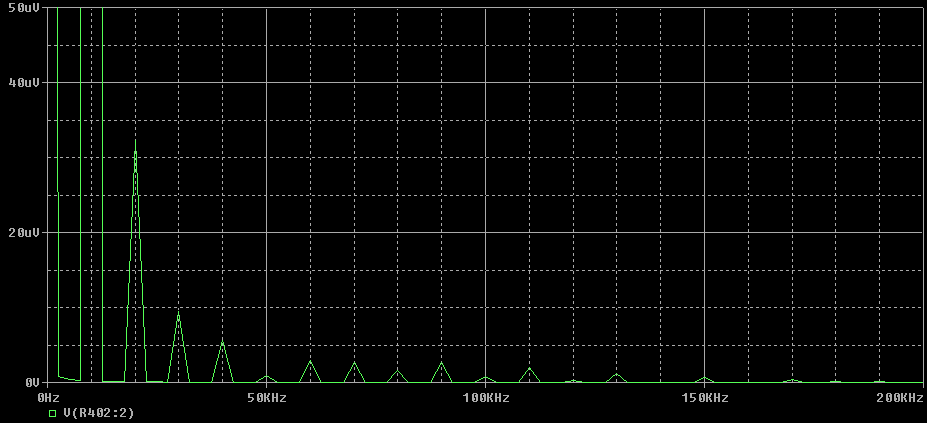
9v peak into 4ohms, 1khz:
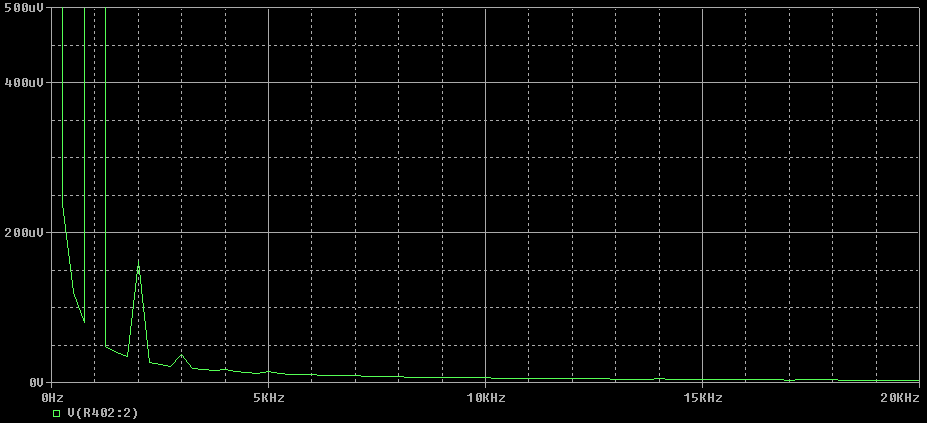
9v peak into 4ohms, 10khz:
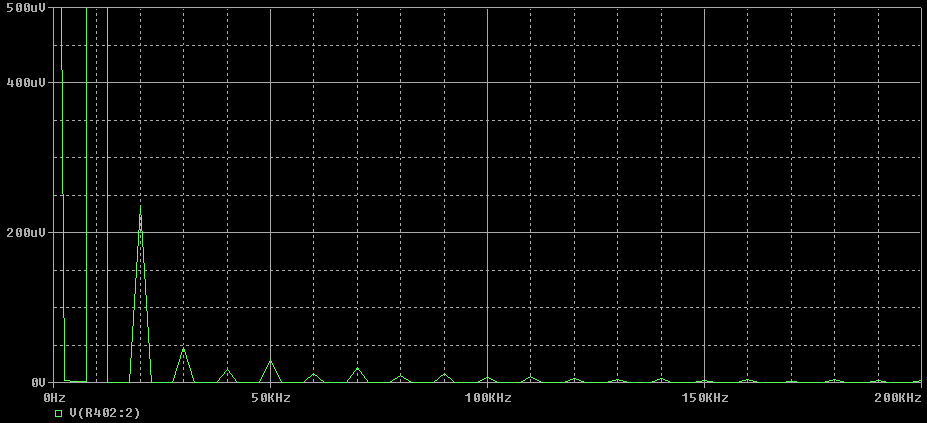
28v peak into 4ohms, 1khz:
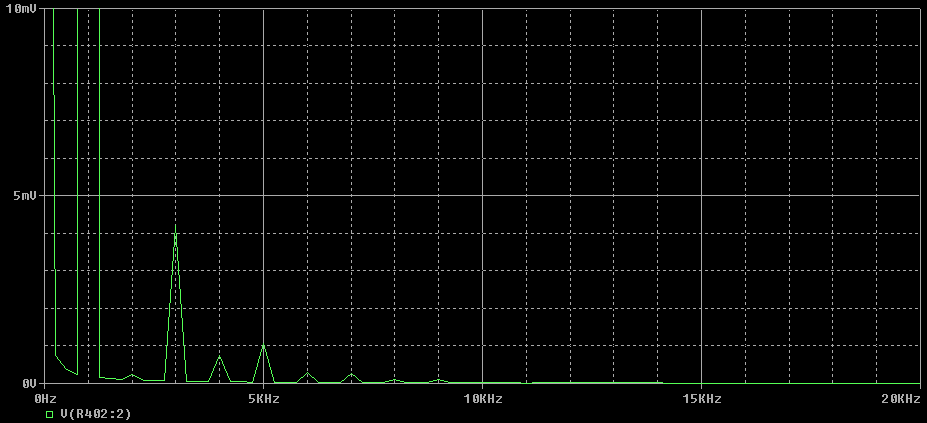
28v peak into 4ohms, 10khz:
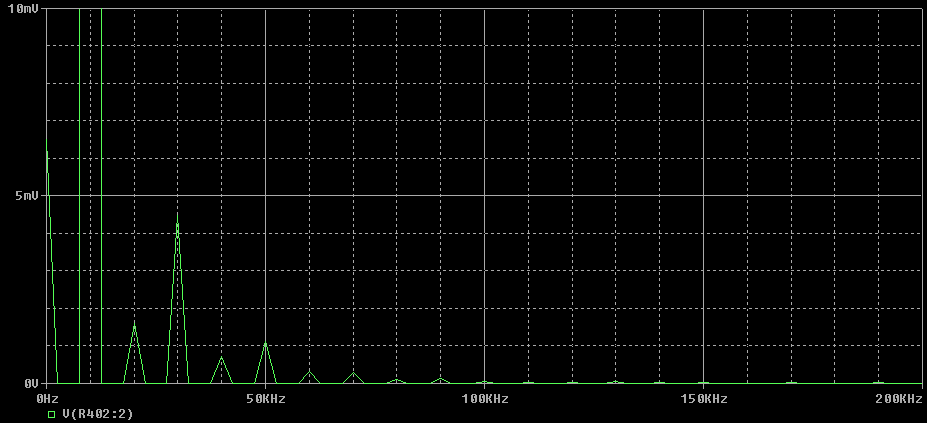
2.8v = 1watt rms
9v = 10watt rms
28v = 100watt rms
Mike
Hi !
I just realized that i have not posted some distortion-plots yet...
Here they are:
2.8v peak into 4ohms, 1khz:

2.8v peak into 4ohms, 10khz:

9v peak into 4ohms, 1khz:

9v peak into 4ohms, 10khz:

28v peak into 4ohms, 1khz:

28v peak into 4ohms, 10khz:

2.8v = 1watt rms
9v = 10watt rms
28v = 100watt rms
Mike
Thank you Mike...having more graphics, post them here, as there are a lot of people
That loves to observe charts and graphics to have more detailed informations.
Yes, i know you already published a text with all amplifiers characteristics...but was text...maybe some more analisis charts will be helpfull and will turn happy a lot of guys.
regards,
Carlos
That loves to observe charts and graphics to have more detailed informations.
Yes, i know you already published a text with all amplifiers characteristics...but was text...maybe some more analisis charts will be helpfull and will turn happy a lot of guys.
regards,
Carlos
- Home
- Amplifiers
- Solid State
- Explendid amplifier designed by Michael Bittner, our MikeB
